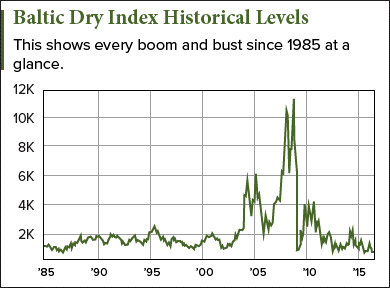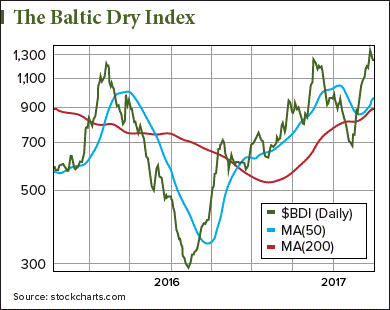Global growth sentiment sure seems bullish at the moment – notwithstanding a couple of “permanently debated,” eternally worrisome factors media pundits love fret about, like China’s juggernaut consumer economy and the U.S. employment picture.
But this is the age of “fake news,” of course. It can be tough for regular investors to discern helpful fact from dangerous fiction where the global economy is concerned, especially when we know that certain players (the world’s central banks, for instance) nearly always play it fast and loose where truth is concerned.
[ad#Google Adsense 336×280-IA]But I’m going to prove that this growth is the real deal.
There’s one number investors can always use to gauge the overall health of the world economy… in a second.
It’s completely devoid of the speculation, padded numbers, and “hopium” that can drastically impact other indicators, so you know instantly you can trust it.
It’s exceedingly simple: If this number’s going up, you can safely go “long” on growth.
And I recommend doing just that with the undervalued shares I’m about to show you…
From the Sea, Global Growth
One of the best measures of the health of global trade is the Baltic Dry Index (IND: BDIY). It tracks the price of shipping major raw materials like wheat, iron ore, cement, and coal.
The BDI was created by the London Baltic Exchange, which calculates the index by surveying a panel of shipbrokers. In fact, the BDI is determined by combining three sub-indices, each of which represents carriers of a particular category: Capesize, Panamax, and Supramax. About 50 different shipping routes are taken into account.
It’s especially relevant because this segment of economic activity, the shipping of raw goods, is often early in the production chain and is a significant component of input costs.
That makes the BDI a widely regarded leading indicator of commercial activity.
When the BDI rises strongly, it suggests a tight market, where demand is robust while supply is limited. This confluence of factors often leads to inflationary pressures.
And lately, the BDI has been providing signals that the global economy is “waking up.”
I’ll show you why in a minute, once we take a closer look at this remarkably useful index.
A New Bull Market Is Shaping Up
The Baltic Dry Index has been published since 1985.
For the first 17 years, the BDI “floated around,” bopping up and down between about 500 and 2,000. Then the commodities boom arrived, along with massive raw materials consumption from China, which in turn produced and shipped every product imaginable overseas.
 That expansion took the BDI from roughly 1,000 to its peak on May 20, 2008, at 11,793.
That expansion took the BDI from roughly 1,000 to its peak on May 20, 2008, at 11,793.
Within just six months, the index had crashed, courtesy of the 2008 Financial Crisis.
Then it got worse.
I remember a mutual fund’s chief investment officer telling me a remarkable anecdote in early 2009…
He explained how, in the aftermath of the 2008 Financial Crisis, there were ships stacked with cargo just floating around, unable to leave their port of departure.
Turns out exporters had no more faith in the Letter of Credit payments being issued by their customers’ banks, many of which were teetering just inches away from failing.
The Baltic Dry Index had crashed by 94% to just 663. Shipping companies could no longer remain profitable. As you can imagine, that devastated rates. Shipping companies, bogged down with large debts for future ships under construction, were crushed. Many failed.
With the stock market recovery taking hold later in 2009, the index regained the 4,000 level. But that was short-lived, as economic activity remained subdued. On Feb. 10, 2016, the BDI had plummeted to an all-time low of 290.
In all likeliness, that marked a secular bottom for shipping rates.
By November, the index had soared back above 1,000. The industry had entered a new bull market.
After a sharp but short correction between December and February, the BDI has quickly rebounded, currently sitting above 1,200.
 That’s given us a great opportunity at a great price…
That’s given us a great opportunity at a great price…
You Can Grab This Stock for 66% of Its Book Value Now
Between mid-February and late March, shipping rates gained a stunning 85%.
Just recently a Morgan Stanley analyst said that, in his view, the dry bulk market had seen its bottom and the sector was returning to profitability.
He rerated a number of shipping companies, upgrading their outlook. Many of these have soared from their lows.
I agree, though I think some have likely gotten a bit ahead of themselves, up by 200% and even 300%.
Still, many of these companies lost over 90% of their market caps. So the upside potential remains huge.
One name I especially like is Golden Ocean Group Ltd. (Nasdaq: GOGL).
Golden Ocean is a leading dry bulk shipper, boasting 77 operational vessels with an average age of just four years. The company is responsible for the management of another 45 vessels, having acquired two shipping companies in all-share deals while the market was severely depressed.
I think that’s going to prove a well-calculated strategic decision, and it’s not the only one. Management wisely restructured loan amortizations last year to significantly reduce breakeven requirements for some time.
Despite a sizable debt position, cash on hand is nearly a quarter of market cap.
Even with its recent stock price gains, the company still trades a full one-third below its book value.
If you want to participate but take a more cautious approach, look for a pullback in Golden Ocean to the $6-$6.50 price range before wading in. More aggressive traders can buy now, but either way, I recommend using a trailing stop loss to protect your capital and profits, as this is a sector rife with volatility.
The shipping industry looks like it’s finally emerging from its multiyear retreat. China remains a major consumer of raw materials and infrastructure spending is ramping up significantly. What’s more, ship fleets are projected to see long-term growth decelerate considerably, portending strong support for higher shipping rates for the foreseeable future.
— Peter Krauth
[ad#mmpress]
Source: Money Morning
